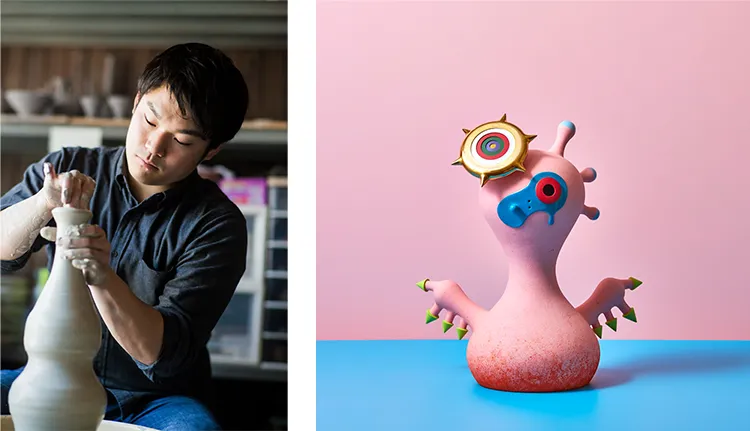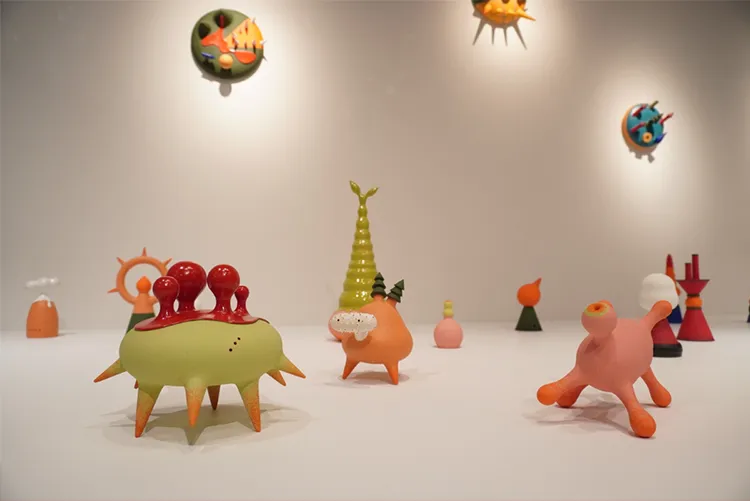Shaping Beginnings: The Journey from Industry to Art
Born in Aichi Prefecture, Japan, in 1989, Tomoya Sakai’s early years were spent working in an auto parts manufacturing plant. There, he honed his skills in metallic processing using a lathe. This period in his life was pivotal as it ignited his fascination with shaping materials, though it wasn’t until later that he would discover his true passion. The allure of working with metal lay in its mechanical precision, yet Sakai yearned for something more expressive and organic. This desire led him to Nagoya University of Arts in 2011, where he majored in ceramics. His first encounter with the pottery wheel was a revelation; the tactile engagement and the tension of the spinning clay captivated him, marking the beginning of his journey into the world of ceramics.
Sakai’s transition from metalwork to ceramics was driven by a profound need to express himself through a more fluid medium. The rigidity and precision of metalwork, while satisfying, did not fulfill his creative aspirations. At Nagoya University of Arts, Sakai dedicated himself to mastering the electric potter’s wheel, initially with the goal of becoming an art teacher. However, the pull of creating with clay was too strong to ignore. This newfound passion marked a significant shift in his career trajectory, leading him down a path that would eventually see him become a full-time ceramic artist.
The years following his graduation were spent teaching art, a role that he found fulfilling yet not entirely satisfying. The lure of ceramics persisted, prompting Sakai to further his studies at the Tajimi City Pottery Design and Technical Center in 2017. This advanced training deepened his skills and understanding of the art form, culminating in his decision to pursue ceramics professionally. By 2019, Sakai had established himself as an independent ceramic artist in Seto City, a renowned hub for ceramic production in Japan, fully committing to his artistic journey.

Tomoya Sakai: Crafting Memories Through Clay
Tomoya Sakai’s work is distinguished by its vivid colors and enigmatic shapes, which are deeply influenced by an eclectic mix of inspirations, from natural objects and architectural forms to scenes from animations and films. His creative process often begins with chaotic mental images that emerge as he spins the potter’s wheel. By reorganizing these fragmented visions, he transforms them into abstract forms that evoke imagined landscapes and sceneries. This intricate process reflects his ongoing series focused on the theme of memory—personal, collective, and temporal.
The concept of memory plays a central role in Sakai’s artistry. He views memories as the building blocks of human personality and worldview, with each experience adding to the complex mosaic of our identities. Through his art, Sakai delves into these memories, seeking to understand the essence of human existence. His process involves a meditative use of the pottery wheel, where he disassembles and reconstructs imprinted images, resulting in shapes that exist in a liminal space between the unconscious and conscious, the abstract and the concrete. This exploration allows him to question and redefine his own identity and the nature of human perception.
Sakai’s ability to manifest abstract memories into tangible forms has garnered him international recognition. His works have been featured in prestigious collections, including the Faenza International Museum of Ceramic Art in Italy, the Gyeonggi Museum of Contemporary Ceramic Art in Korea, and the New Taipei City Yingge Ceramics Museum in Taiwan. This global acknowledgment not only validates the emotional and philosophical depth of his creations but also fuels his drive to push the boundaries of ceramic art. Sakai’s journey is a testament to the transformative power of art, both for the creator and the observer.

The Alchemy of Clay: Transforming Inspiration into Art
The transformation of inspiration into art is a meticulous process for Tomoya Sakai. Drawing from a diverse array of influences, he begins with a mental image that often lacks clear form or structure. These initial chaotic images are produced by the centrifugal force of the spinning wheel, a method that he finds both challenging and exhilarating. As he works, Sakai reorganizes these images, sculpting them into new, abstract forms that are imbued with his personal vision and artistic intent.
Sakai’s series on memory exemplifies this approach. By focusing on self-memory, the memories of others, and the passage of time, he creates works that resonate on a deeply emotional level. His art invites viewers to reflect on their own experiences and the ways in which memories shape their identities. This process of turning intangible memories into concrete forms is not just about artistic expression; it is also a means of exploring the subconscious mind and the fragments of our past that influence our present.
The recognition Sakai has received for his work underscores the universal appeal of his artistic exploration. His pieces, housed in collections around the world, serve as a bridge between different cultures and perspectives, highlighting the shared human experience of memory and identity. For Sakai, this international recognition is both humbling and motivating, encouraging him to continue refining his craft and expanding his artistic horizons.

Tomoya Sakai: A Catalyst for Reflection in Contemporary Society
In contemporary society, Tomoya Sakai believes that the role of a ceramic artist extends beyond the creation of beautiful objects. It encompasses provoking thought and introspection among viewers. Sakai’s art challenges people to consider how their own memories and experiences shape their perceptions of the world. By doing so, he reveals the diverse ways in which individuals interpret a single image, shedding light on the variations in human identity and perspective.
Through his work, Sakai aims to foster a deeper understanding of the complexities of human society. He posits that by exploring and acknowledging our differences, we can find common ground and ways to coexist more harmoniously. His ceramics serve as a medium for this dialogue, encouraging viewers to reflect on their own identities and the experiences that have shaped them. Sakai’s approach to art is inherently philosophical, aiming to bridge the gap between personal introspection and broader social understanding.
The impact of Sakai’s work on contemporary society is profound. By creating art that resonates on an emotional and intellectual level, he contributes to the ongoing conversation about identity, memory, and human connection. His pieces not only beautify the spaces they inhabit but also provoke meaningful reflection and dialogue among those who encounter them. Through his dedication to his craft and his thoughtful exploration of human experience, Tomoya Sakai has established himself as a significant figure in the world of contemporary ceramic art.





